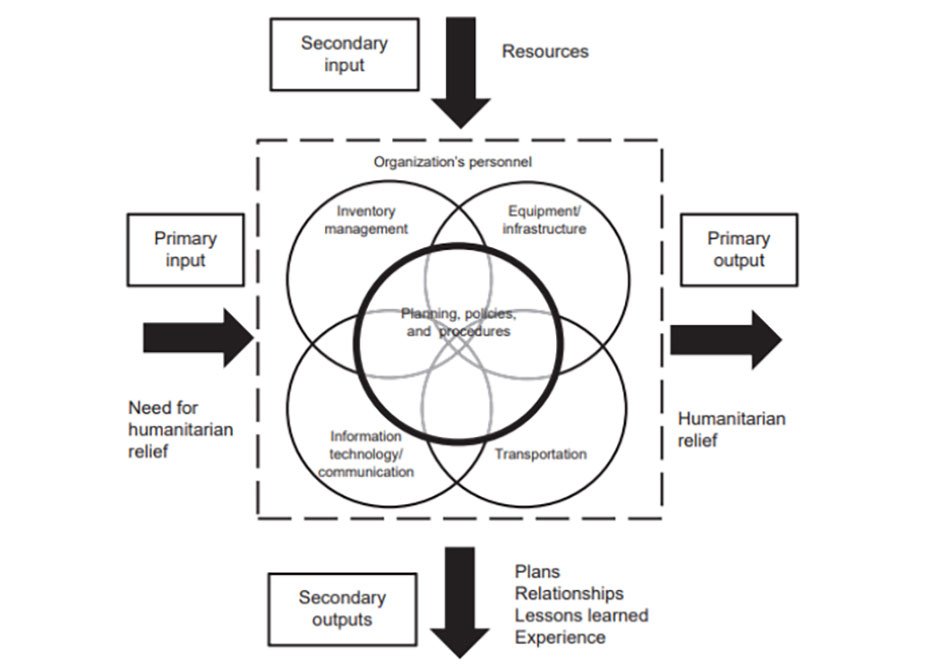By Dalia Alic
Disasters in numbers: approximately 274 million people needed humanitarian assistance and protection in 2022, with additional 17.7 million people in need due to the war in Ukraine. Displacements show no sign of slowing as hundreds of millions of people are without shelter, food, health services and education, surviving from crisis to the crisis caused either by war, natural disasters, famine or disease outbreaks.
During the largest global food crisis in modern history, the resilience and reactivity of existing systems keep getting tested by exponential requests for humanitarian aid. Not to mention human-induced climate change, which resulted in almost a double number of disasters in the last 20 years, directly affecting humanity and the environment worldwide and leaving millions without needed humanitarian aid.
Humanitarian aid is emergency relief to people in need, which safeguards lives, alleviates suffering and protects human dignity in all phases of emergency management: mitigation, preparedness, response and recovery. Humanitarian logistics is defined as ‘processes and systems involved in mobilizing people, resources, skills and knowledge to help vulnerable people affected by natural disasters and complex emergencies’. As such, it requires different actors to operate together and effectively coordinate aid actions with maximized time efficiency and minimized costs.
Successful humanitarian crisis management needs agility and adaptability to provide quality and fast responses to affected communities and places of a disaster. Humanitarian aid operations demand an effective humanitarian supply chain management strategy and successful execution, often with a multilateral approach that involves two-sided flow of supplies, information and resources between agencies, organizations and distribution centres to reach victims and affected area.
Existing infrastructures are often challenged by the pressure to process large amounts of data quickly and accurately and sometimes handle an unexpected influx of requests. Overloaded systems and operations often struggle to meet the demands for the fast delivery of the humanitarian response – with demands skyrocketing, and the pace will be impossible to meet.
Intelligent automation solutions can reshape humanitarian crisis management, resulting in faster supply distribution and a swifter response. Unlocking automation’s full potential, primarily Robotic Process Automation (RPA) and Intelligent Automation (IA), respectively, could benefit not just economies, but also development and humanitarian actors globally. Automation is a game changer that could increase the resilience of systems and actors in charge of humanitarian aid, optimize humanitarian aid processes and transform humanitarian crisis management as we know it.
The Role of Automation in Responding to Humanitarian Crises
Intelligent automation enables the sustainable transformation of humanitarian aid operations by increasing the system’s resilience to increased demand, unpredicted challenges and lack of speed through resources and processes optimization and error-free execution. While RPA can be used for data entry, processing reports, claims and inquiries, intelligent automation includes AI capabilities which help organizations automate and streamline more complex processes.
More concretely, automation could help tackle crucial elements of humanitarian crisis management, such as:
- disaster mitigation,
- human resources/recruitment and onboarding,
- finance and accounting,
- faster and more detailed responsiveness,
- supply chain operations synchronization,
- systematical allocation of resources,
- document processing,
- data collection and reporting.
The disaster relief supply chain comprises three primary operations: supply acquisition and procurement, pre-positioning, warehousing, and transportation. All three primary operations require detailed administration, where a faster front-end interface is needed for data entry, including streamlining screening processes and quicker and correct processing of digital paperwork so that relief supplies are effectively managed and distributed.
This is where automation enhances the relief supply chain’s effectiveness and efficiency by speeding up data sharing and synchronization between systems and organizations directly involved in the humanitarian supply chain. Furthermore, intelligent automation capabilities can help interconnect various stakeholders, storage centres, and distribution points to accelerate the distribution of resources, donations, and supplies to humanitarian aid receivers. Additionally, a precise and systematical allocation of resources is guaranteed instead of an impulsive one, even after the first wave of the emergency recovery.

Accelerating Humanitarian Aid Objectives with Automation
Various examples globally have shown that digital transformation can indeed help increase access to relief services and support central and local authorities manage the crisis more effectively and efficiently. Furthermore, automation has already proven as a trustworthy agent of humanitarian aid operations transformation by bringing concrete results and practical solutions.
One such example implies the use of intelligent automation, which can reduce the administrative burden associated with refugee crisis management and ease access for those in need by streamlining processes, inquiries, and various requests for service delivery. For example, the customized software bot ‘Telegram for Humanity’ automates thousands of manual requests incoming from Ukrainian refugees. As a result, automation increases aid delivery in volume, speed and accuracy, saving almost 200 hours of manual processing by volunteers each week.
Automation in advanced food manufacturing for humanitarian aid produces nutritious food for a lower price, ready for immediate delivery. Automated manufacturing of nutritious food has saved more than 11 million lives in 55 countries by lowering the cost of humanitarian efforts and reaching the more affected population, especially children.
Centralized automated technology solution ‘Last Mile Mobile Solutions’ strengthens ‘efficiency, effectiveness and accountability in humanitarian service delivery’ by improving remote data collection, including registration and verification, management of aid recipients, distribution planning, management, monitoring and reporting. Automated processes resulted in at least 50% faster registration of aid recipients, a 30% reduction in project-related budgetary costs for manual activities, a 40% reduction in distribution staff and a corresponding reduction in travel costs, and more. In addition, digitalized data allowed automated processes to rapidly speed up the critical stage of humanitarian aid delivery – the distribution of supplies to affected people.
The digital transformation of the United Nations Volunteers (UNV) programme enabled the use of software robotics to increase compliance, consistency, and productivity through Robotic Process Automation (RPA). UiPath’s automation for UNV accelerated routine and repetitive tasks by increasing the data quality and efficiency of data entry related to the contract management and assignments of UN Volunteers, resulting in saved ‘125 (8-hour) person days, working in the background around the clock and with minimal supervision’ and generated 10,071 personnel action forms to date. Additional implementation of RPA at UNV includes financial reports and account activity analyses, showing that more complex automation can be done under human supervision.

Technological Innovation, Humanitarian Aid and Human Rights
Leveraging automation to strengthen existing digital channels could positively transform the humanitarian operations and outputs we know, resulting in greater efficiencies and effectiveness of delivery of humanitarian assistance to those affected by disasters but also to those focused on disaster mitigation in the first place.
However, any technology used in the context of crisis management and humanitarian aid efforts should be obliged to a human-centric approach, which allows human intervention and oversight. Transforming humanitarian aid operations should never come at the cost of violating human rights and human security. Furthermore, it should be built in a way which disallows digital inequality. The right to privacy and data protection should be fully respected, and all humanitarian aid operations data should be safeguarded from any cyber-attacks or data leaks or misuse. Next-gen technological innovation, such as intelligent automation, should never be used against those who are in need of humanitarian aid.
The current global recovery calls for green, digital and resilient systems in the private and public sectors. Automation could be the sustainable and ‘green’ path to improving humanitarian aid operations – if applied correctly.
This article was originally published on 22 January 2023.
About the Author
 Dalia Alic is an International Research Fellow on Emerging Technology in Europuls – Centre for European Excellence and Centre for AI and Digital Policy Research Group Member, Dalia co-authors research papers with a focus on human security in transnational lawmaking, multilateral treaties and international regulatory frameworks on AI and cybersecurity.
Dalia Alic is an International Research Fellow on Emerging Technology in Europuls – Centre for European Excellence and Centre for AI and Digital Policy Research Group Member, Dalia co-authors research papers with a focus on human security in transnational lawmaking, multilateral treaties and international regulatory frameworks on AI and cybersecurity.
References
- Thomas, Anisya (2005). From Logistics to Supply Chain Management: The Path Forward in the Humanitarian Sector. USA: Fritz Institute.
- Tomasini, R., & Wassenhove, L. van. (2009). Humanitarian logistics. Palgrave Macmillan.
- Yadav, Devendra K & Barve, Akhilesh. (2015). Analysis of critical success factors of humanitarian supply chain: An application of Interpretive Structural Modeling. International Journal of Disaster Risk Reduction. 12. 10.1016/j.ijdrr.2015.01.008.




























